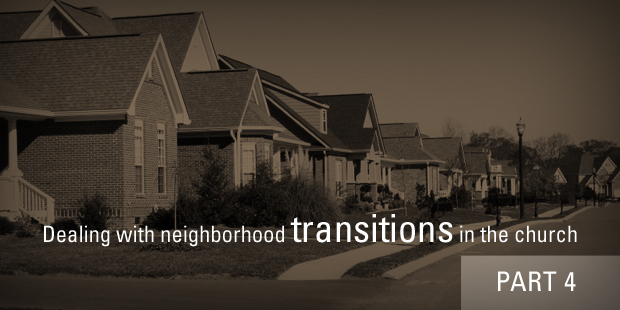
Neighborhood Transitions and the Local Church, Part 4
So far we’ve looked at two options churches typically consider when the neighborhood in which they are located goes through change. The first was to to create a true multicultural church. Those options are often the most common, especially relocating, but they also leave out a third scenario which is becoming more common in large metropolitan culture: multilingual neighborhood churches.
I should add that these are broad categories. You could start another campus, relocate part of the congregation, and be a multilingual multisite. Or, you should move to multicultural ministry AND have language congregations as well. You get the point– these are broad categories.
However, if the community transition is dealing with more distant cultures that speak different languages, an important third response is to create a multilingual church or different congregations meeting in the same buidling (and, better yet, part of the same church).
I once preached at a church in Boston that had five languages represented in the church. They had a multilingual church with different language congregations. In the midst of this, however, they were clearly one, unified church They shared an elder board containing people from each of the congregations who prayed together, worked together, and led together along the way.
I think that the best scenario is not relocation (option 1), though I understand there are times and situations when that it the best thing to do– and congregations need to listen to the leadership of the Lord. The church is not a building and, if the church has moved far from its building, something has to be done with the building. So, if you relocate, start another church and ministry in the building the Lord gave you.
However, I think multicultural transition is a better choice, either in one multicultural congregation (option 2) or in multiple congregations in one facility or (even better) one church (option 3). With that in mind, let me conclude with some thoughts that are applicable to both options 2 and 3.
Practically speaking, how can this pursuit for a genuine multicultural community in a transitional neighborhood be accomplished? Based on my own limited experience, and more broad experience researching and consulting with churches, I see five foundational steps:
- Begin to build leadership reflective of the community. When we were planting our church in Buffalo, our neighborhood was about 40 percent African-American, 30 percent Anglo, and the rest was a mix of other races. We tried to model those percentages in our leadership from the very beginning. The community responded.
- Intentionally engage ethnicities present. Multicultural engagement will not happen by accident. A strategic plan should be created. Intentionally seek sufficient knowledge and background about the culture from someone who knows this information.
- Move beyond tokenism and give actual representative leadership.Disingenuity will be spotted a mile away. Multicultural leadership must be present across the church: in worship, administration, and teaching to name a few areas.
- Consider calling a pastor that is reflective of the predominant ethnicity of the community. Ultimately, it is God’s call who to place as pastor, but be intentional, however, to broaden the search to include candidates from a number of different backgrounds.
- Reflect the values of the Kingdom of God. Above all else, our church, and the people that make it up, needs to be a picture of Heaven on Earth. Only through God’s grace, love, and guidance can this kind of miracle happen. I can’t think of too many other images that can better illustrate what Jesus Christ can do in the hearts and minds of people who love Him first and each other second.
Since pursuing a multicultural setting goes against individuals’ natural tendencies toward homogeneity, church growth WILL be slower. Nevertheless, when God gives the opportunity to move to multiculturalism, take the risk and make the commitment. When changed lives are the fruit, it’s worth it.
This is the final post in a series of 4; read the rest here: Part 1, Part 2, and Part 3.
Read more from Ed here.

Tags: Ed Stetzer, Local Predicament, Multicultural, Recasting Vision













